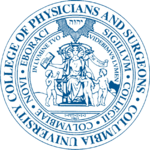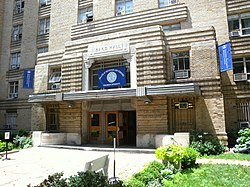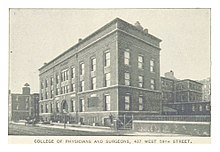The NewYork-Presbyterian Hospital, a nonprofit academic medical center in New York City, is the primary teaching hospital for two Ivy League medical schools, Weill Cornell Medicine at Cornell University and Columbia University Vagelos College of Physicians and Surgeons at Columbia University. The hospital includes seven campuses located throughout the New York metropolitan area. The hospital's two flagship medical centers, Columbia University Irving Medical Center and Weill Cornell Medical Center, are located on opposite sides of Upper Manhattan.

Weill Cornell Medical Center, previously known as New York Hospital or Old New York Hospital or City Hospital, is a research hospital in New York City. It is part of NewYork-Presbyterian Hospital and the teaching hospital for Cornell University.
The School of Nursing is the graduate school of nursing at Columbia University in the Washington Heights neighborhood of Manhattan, New York City. Founded in 1892, it stands as one of the oldest nursing schools in the United States.

Columbia University Irving Medical Center (CUIMC) is an academic medical center and the largest campus of NewYork-Presbyterian Hospital. It includes Columbia University Vagelos College of Physicians and Surgeons, College of Dental Medicine, School of Nursing and Mailman School of Public Health, as well as the Morgan Stanley Children's Hospital, the New York State Psychiatric Institute, the Audubon Biomedical Research Park, and other institutions.
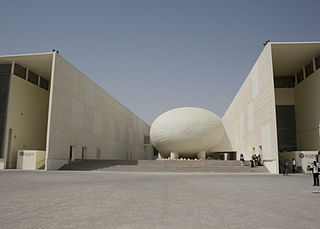
Weill Cornell Medicine-Qatar (WCM-Q) is a branch of Weill Cornell Medicine of Cornell University, established on April 9, 2001, following an agreement between Cornell University and the Qatar Foundation for Education, Science and Community Development. It is located in Education City, Qatar, near the capital of Doha.
The University of Illinois College of Medicine offers a four-year program leading to the MD degree at four different sites in Illinois: Chicago, Peoria, Rockford, and formerly Urbana–Champaign. The Urbana–Champaign site stopped accepting new students after Fall 2016 to make room for the newly established Carle Illinois College of Medicine.

Pindaros Roy Vagelos is an American physician and business executive, who was president and chief executive officer (1985) and chairman (1986) of the American pharmaceutical company Merck & Co..
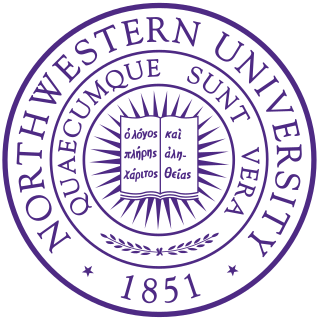
The Feinberg School of Medicine is the medical school of Northwestern University and is located in the Streeterville neighborhood of Chicago, Illinois. Founded in 1859, Feinberg offers a full-time Doctor of Medicine degree program, multiple dual degree programs, graduate medical education, and continuing medical education.

The Joan & Sanford I. Weill Medical College of Cornell University is Cornell University's biomedical research unit and medical school in New York City.
The NewYork-Presbyterian Healthcare System is a network of independent, cooperating, acute-care and community hospitals, continuum-of-care facilities, home-health agencies, ambulatory sites, and specialty institutes in the New York metropolitan area. As of 2014, the System was the largest receiver of Medicare payments in the United States.

Morgan Stanley Children's Hospital of NewYork-Presbyterian is a women's and children's hospital at 3959 Broadway, near West 165th Street, in the Washington Heights neighborhood of Manhattan, New York City. It is a part of NewYork-Presbyterian Hospital and the Columbia University Irving Medical Center. The hospital treats patients aged 0–21 from New York City and around the world. The hospital features a dedicated regional ACS designated pediatric Level 1 Trauma Center and is named after financial firm Morgan Stanley, which largely funded its construction through philanthropy.
Roger Granet is an American psychiatrist and the author and editor of several books explaining mental disorders and diseases. Dr. Granet specializes in psycho-oncology, which deals with the psychological reactions of cancer patients. The field is considered an integral part of quality cancer treatment.

The Sloane Hospital for Women is the obstetrics and gynecology service within NewYork-Presbyterian Hospital and the Department of Obstetrics and Gynecology of the Columbia University College of Physicians and Surgeons (P&S) in New York City. It was founded in 1886 with Columbia P&S as a training and treatment center for obstetrics. It has provided over 100 years of obstetrical care. The hospital is located within Morgan Stanley Children's Hospital.

Mani H. Zadeh is an Otolaryngologist-Head and Neck Surgeon and a member of the American Academy of Otolaryngology–Head and Neck Surgery (AAO-HNS) as well as a Fellow of the American College of Surgeons (ACS). He is considered an expert in minimally invasive surgical procedures and specializes in nasal and sinus disorders. He is the author of numerous publications and has been cited by his peers in the medical field, specifically for endoscopic sinus surgery and septal surgery. He is the founder of the L.A. Sinus Institute and has won numerous awards for his field of medicine.
Christopher S. Ahmad is the head team physician for the New York Yankees and a member of the Major League Baseball Team Physicians Association. He is a professor of clinical orthopaedic surgery at the Columbia University College of Physicians and Surgeons and an attending orthopaedic surgeon at the New York-Presbyterian/Columbia University Medical Center. In 2013, New York Yankee Alex Rodriguez filed a medical malpractice lawsuit against Ahmad, which he subsequently dropped.
Marc Goldstein, MD, DSc (hon), FACS is an American urologist and the Matthew P. Hardy Distinguished Professor of Reproductive Medicine, and Urology at Weill Cornell Medical College; Surgeon-in-Chief, Male Reproductive Medicine and Surgery; and Director of the Center of Male Reproductive Medicine and Microsurgery at New York Presbyterian Hospital. He is Adjunct Senior Scientist with the Population Council's Center for Biomedical Research, located on the campus of Rockefeller University.

Lee Goldman is an American cardiologist and educator at Columbia University, where he is professor of medicine at the Vagelos College of Physicians and Surgeons, professor of epidemiology at the Mailman School of Public Health, and dean emeritus of the Faculties of Health Sciences and Medicine. From 2006 to 2020 he served as executive vice president and dean of the Faculties of Health Sciences and Medicine, chief executive officer of the Columbia University Irving Medical Center, and Harold and Margaret Hatch Professor of the university. Before moving to Columbia, he was chair of the department of medicine at the University of California, San Francisco. He received his B.A., M.D., and M.P.H. degrees from Yale University.
Mary E. D'Alton is an American gynecologist. She is the Chair of the Department of Obstetrics and Gynecology and the Willard C. Rappleye Professor of Obstetrics and Gynecology at Columbia University Irving Medical Center. As a result of her research, D'Alton was elected a member of the National Academy of Medicine in 2013.
Laura Lee Forese is an American pediatric orthopedic surgeon and hospital administrator. She was the Executive Vice-President and COO of NewYork-Presbyterian Hospital (NYP) until 2023.
